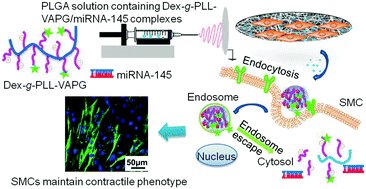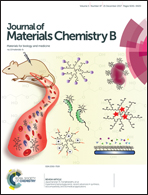Functional electrospun fibrous scaffolds with dextran-g-poly(l-lysine)-VAPG/microRNA-145 to specially modulate vascular SMCs†
Abstract
Modulation of gene expression via microRNAs (miRNAs) has been attractive as one of the promising strategies to cope with cardiovascular diseases, and the target-delivery of functional miRNAs to a specific vascular tissue is of importance. By the incorporation of Val-Ala-Pro-Gly (VAPG), a specific adhesive peptide to vascular smooth muscle cells (SMCs), local delivery of miRNAs to tissue-engineered vascular grafts could be a prevailing approach. In this work, functional electrospun poly(lactide-co-glycolide) (PLGA) membranes were developed by loading dextran-g-poly(L-lysine)-VAPG/miRNA-145 (DPVm) complexes to modulate the phenotype and proliferation of SMCs. The polymer/miRNA-145 complexes exhibited trivial cytotoxicity, excellent serum stability and enhanced cellular uptake by SMCs, over the vascular endothelial cells. When encapsulated into the electrospun PLGA membrane, miRNA-145 presented controlled release as well as good biological activity. It was found that the electrospun membranes were able to support the adhesion and spreading of SMCs. In addition, significant down-regulation of Krüppel-like factor 4 expression and up-regulation of myocardin and α-smooth muscle actin expression at both the gene and protein levels were detected on day 3. Meanwhile, due to the sustained release of miRNA-145, SMCs maintained the contractile phenotype at a slow proliferation rate compared with the negative control. One month of replacement of rabbit carotid artery by the functional bilayer electrospun scaffold, which was prepared with poly(ethylene glycol)-b-poly(L-lactide-co-ε-caprolactone) as the inner layer and PLGA containing DPVm complexes as the outer layer, demonstrated that the vascular graft containing miRNA-145 could also be efficient for modulating the SMC phenotype in vivo. It was suggested that encapsulation of miRNA-145 complexes in small-diameter scaffolds could serve as an effective approach to prevent intimal hyperplasia during vascular tissue regeneration.



 Please wait while we load your content...
Please wait while we load your content...